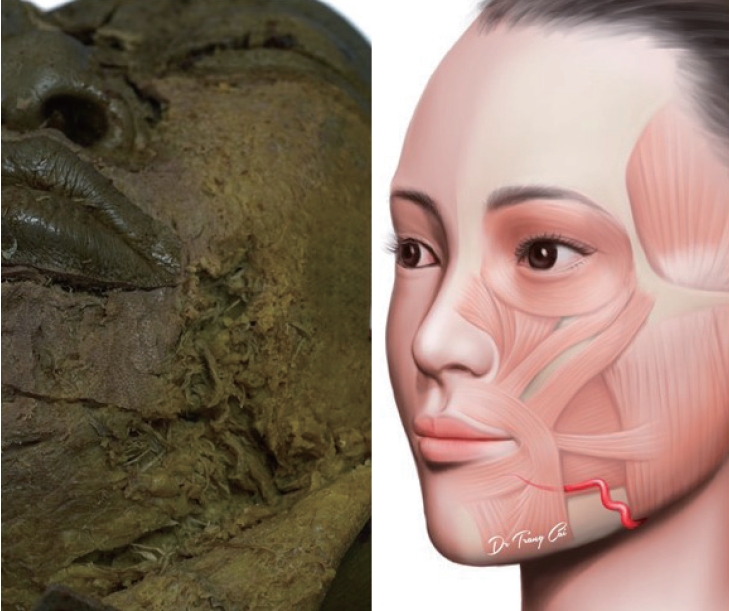 |
 |
- Search
| Arch Craniofac Surg > Volume 25(2); 2024 > Article |
|
Abstract
Background
Methods
Results
Conclusion
Notes
Funding
This study was supported by the University of Medicine and Pharmacy, Ho Chi Minh City, Vietnam.
Ethical approval
This study was approved by the University of Medicine and Pharmacy at Ho Chi Minh City 2 (No. IRB-VN01002/IRB00010293/FWA00023448).
Author contributions
Conceptualization; Data curation; Formal analysis; Methodology; Project administration: Vu Hoang Nguyen, Trang Huu Ngoc Thao Cai, Tuan Anh Nguyen, Lin Cheng-Kuan. Visualization: Vu Hoang Nguyen, Trang Huu Ngoc Thao Cai. Writing - original draft: Trang Huu Ngoc Thao Cai. Writing - review & editing: Trang Huu Ngoc Thao Cai, Vu Hoang Nguyen, Tuan Anh Nguyen, Lin Cheng-Kuan. Investigation: Vu Hoang Nguyen, Trang Huu Ngoc Thao Cai, Tuan Anh Nguyen, Lin Cheng- Kuan. Resources: Vu Hoang Nguyen, Trang Huu Ngoc Thao Cai. Software: Trang Huu Ngoc Thao Cai, Lin Cheng-Kuan. Supervision; Validation: Vu Hoang Nguyen, Trang Huu Ngoc Thao Cai, Tuan Anh Nguyen, Lin Cheng-Kuan.
Fig. 1.
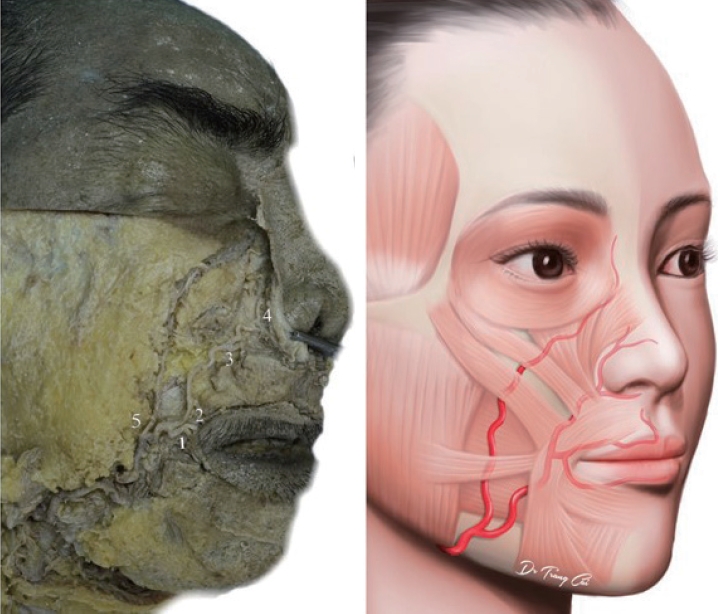
Fig. 2.
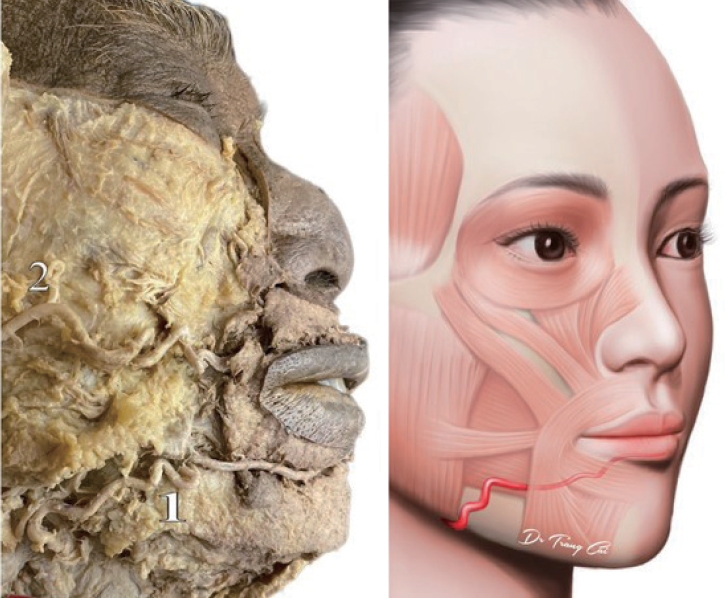
Fig. 3.

Fig. 4.

Fig. 5.
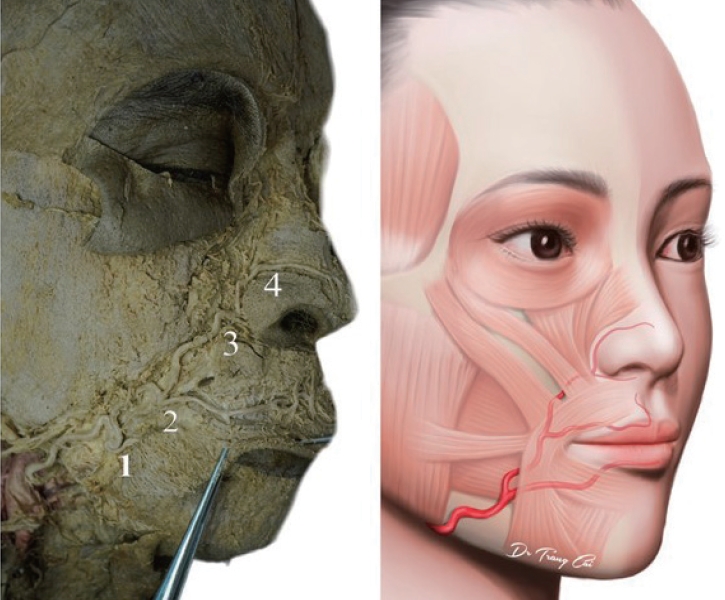
Fig. 6.

Fig. 7.

Fig. 8.
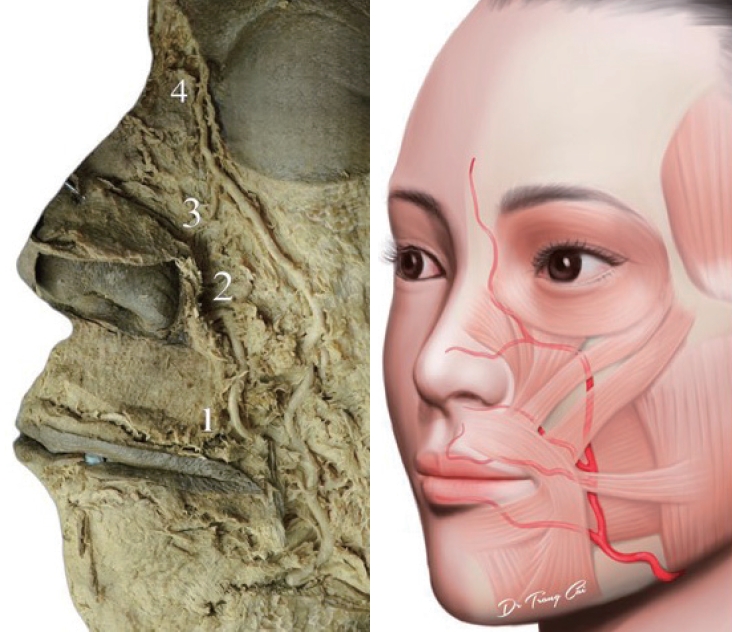
Table 1.
FA, facial artery; IL, inferior labial; ILA, IL artery; SL, superior labial; SLA, SL artery; IA, inferior alar; IAA, IA artery; LN, lateral nasal; LNA, LN artery; At, angular artery typical; AA, angular artery; AA-OOc, AA along the lower border of the orbicularis oculi muscle; F, forehead branch; IOT, infraorbital trunk.
Table 2.
| Author (year) | No. | ILA | SLA | IAA | LNA | AA/F | D | H |
|---|---|---|---|---|---|---|---|---|
| Our study (2023) | 102 (52 cadavers) | 5 (4.9) | 5 (4.9) | 7 (6.9) | 33 (32.4) | 33 (32.4)a) | 18 (17.7) | 1 (1.0) |
| Koziej et al. (2022) [6] | 2,119 (meta-analysis) | 15.6 | 15.6 | 5.9 | 69.8 | 1.7 | 0.8 | |
| Wang et al. (2022) [20] | 300 (150 CTA cases) | 70 (23.3) | 163 (54.3) | 49 (16.3) | 18 (6.0) | - | ||
| Tansatit et al. (2021) [21] | 62 (31 cadavers) | - | 3 (4.8) | - | 5 (8.1) | - | - | - |
| Hong et al. (2020) [22] | 284 (198 CTA cases) | 18 (6.3) | 24 (8.5) | - | 138 (48.6) | 90 (31.7)b) | - | - |
| Niemann et al. (2019) [12] | 39 (20 cadavers) | 1 (2.6) | 1 (2.6) | - | 25 (64.1) | 7 (18.0) | - | 1 (2.6) |
| Koziej et al. (2019) [7] | 255 (131 CTA cases) | 63 (24.7) | 63 (24.7) | 80 (31.4) | 102 (40.0) | 4 (1.6) | 6 (2.3) | |
| Vasudha et al. (2018) [23] | 50 (25 cadavers) | - | 15 (30.0) | - | 6 (12.0) | 28 (56.0) | - | 1 (2.0) |
| Pilsl et al. (2016) [14] | 60 (30 CTA cadavers) | 11 (18.3) | - | 16 (26.7) | 25 (41.7) | 8 (13.3) | - | |
| Lee et al. (2018) [8] | 60 (36 cadavers) | 4 (6.7) | 9 (15.0) | - | 47 (78.3) | - | - | |
| Dickson et al. (2013) [2] | 40 (21 cadavers) | - | 17 (42.5) | 3 (7.5) | - | 20 (50.0) | - | - |
| Furukawa et al. (2013) [4] | 187 (94 CTA cases) | - | 64 (34.2) | 74 (39.6) | 45 (24.1) | 4 (2.1) | - | |
| Kulkarni et al. (2013) [19] | 100 (50 cadavers) | - | 20 (20.0) | - | 44 (44.0) | 36 (36.0) | - | - |
| Lohn et al. (2011) [9] | 201 (112 cadavers) | 6 (3.0) | 20 (10.0) | 35 (17.0) | 96 (48.0) | 40 (20.0) | - | 4 (2.0) |
| Loukas et al. (2006) [10] | 284 (142 cadavers) | 24 (8.5) | - | 110 (38.7) | 135 (47.5) | 11 (3.9) | 4 (1.4) | |
| Pinar et al. (2005) [15] | 50 (25 cadavers) | 1 (2.0) | 2 (4.0) | 6 (12.0) | 30 (60.0) | 11 (22.0) | - | - |
| Koh et al. (2003) [24] | 91 (47 cadavers) | 5 (5.5) | 6 (6.6) | 3 (3.3) | 40 (44.0) | 26 (28.5) | 11 (12.1) | - |
| Gardetto et al. (2002) [5] | 44 (22 cadavers) | - | 2 (4.5) | 6 (13.5) | - | 34 (77.4) | 2 (4.5) | - |
| Dupoirieux et al. (1999) [3] | 20 (10 cadavers) | - | 7 (35.0) | - | 9 (45.0) | 4 (20.0) | - | - |
| Niranjan (1988) [13] | 50 (25 cadavers) | - | 2 (4.0) | 1 (2.0) | - | 42 (84.0) | 5 (10.0) | - |
| Mitz et al. (1973) [11] | 100 (50 cadavers) | 8 (8.0) | 10 (10.0) | - | - | 78 (78.0) | 4 (4.0) | - |





